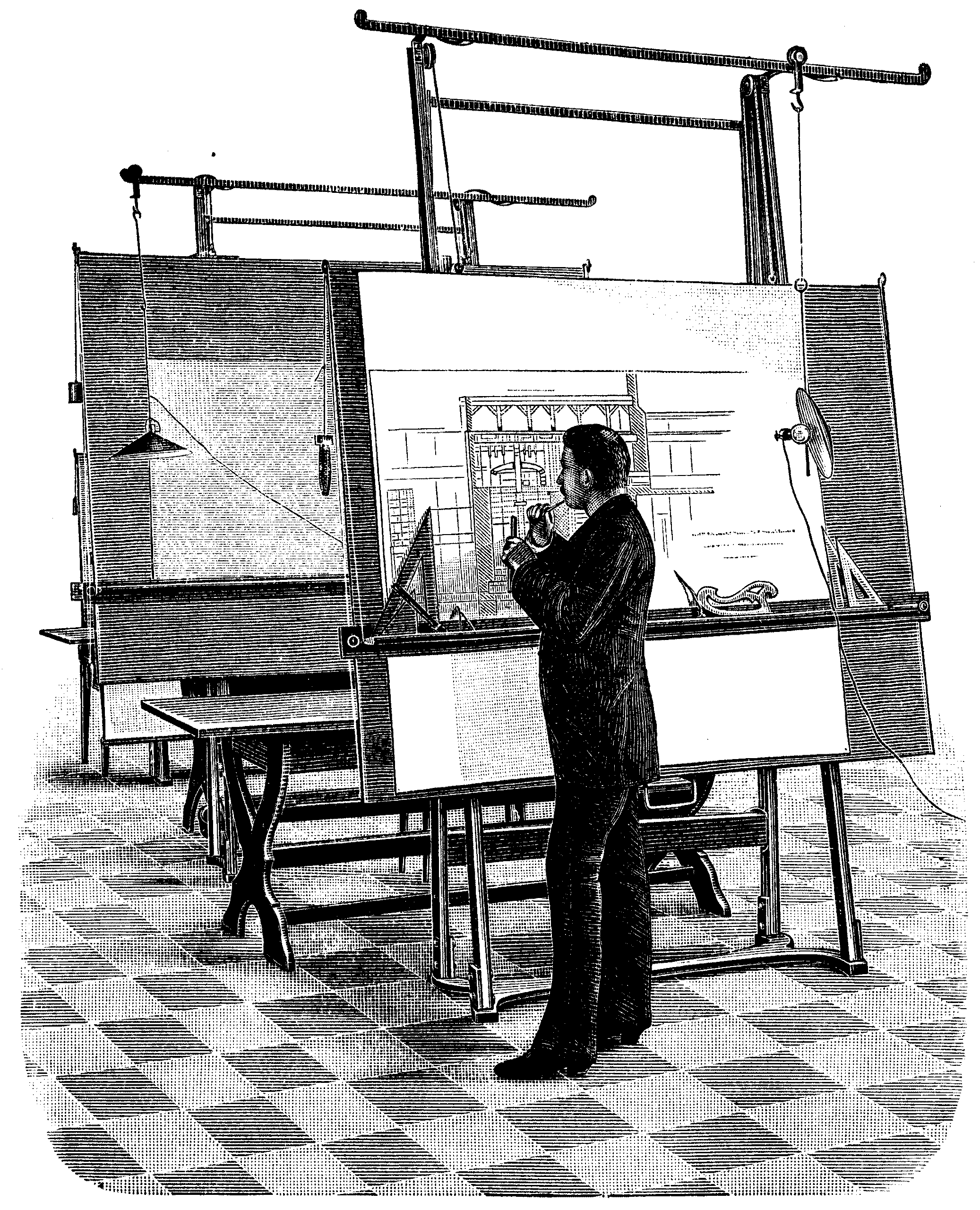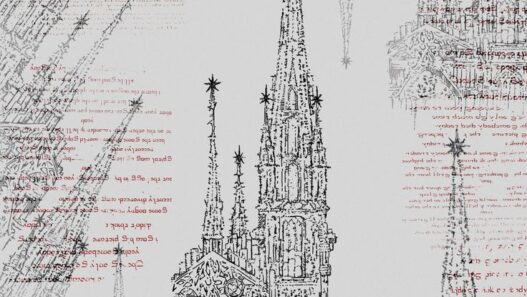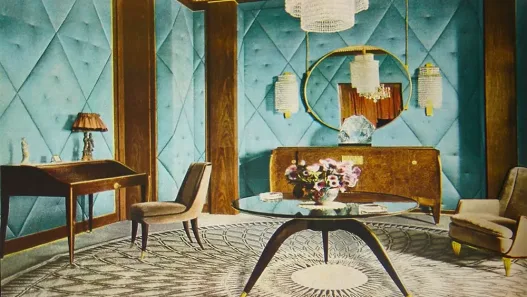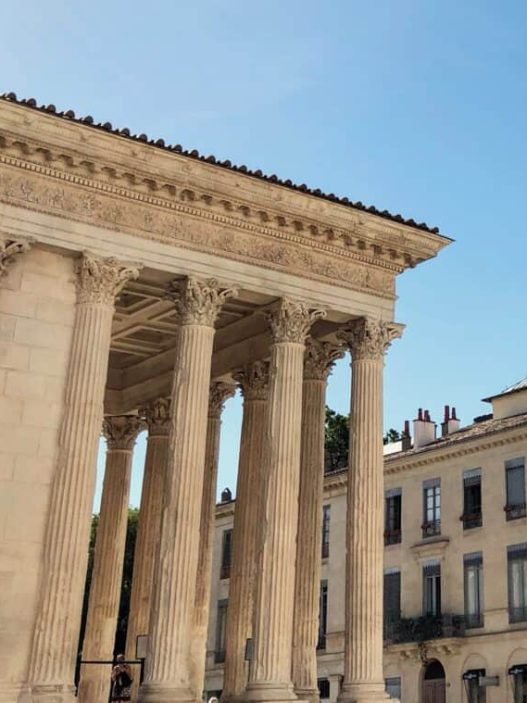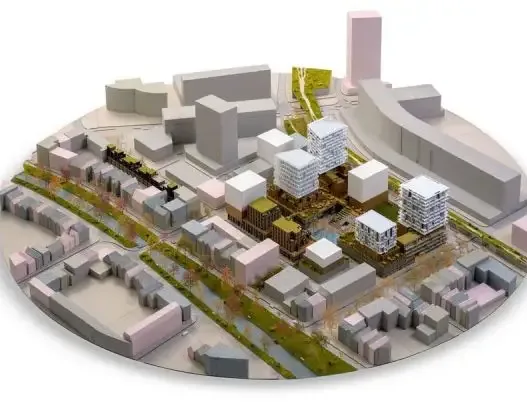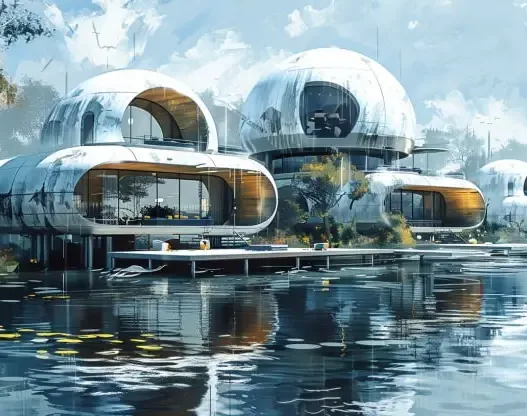Art Deco is much more than a design style; it represents a cultural movement that flourished in the early 20th century, particularly in the 1920s and 1930s. This period is marked by a unique blend of modernity and elegance, reflecting the optimism and dynamism of the post-World War I world. The influence of Art Deco can be seen in architecture, fashion, visual arts and even everyday objects, leaving an indelible mark on urban spaces that still resonates today.

Definition of Art Deco
Art Deco, short for Arts Décoratifs, is a decorative style characterised by bold geometric shapes, vibrant colours and luxurious materials. It emerged as a response to the more ornate and elaborate styles that preceded it, such as Art Nouveau. While Art Nouveau was organic and fluid, Art Deco embraced symmetry and streamlined forms and epitomised the modern era. This style is characterised by the use of new technologies and materials such as chrome, glass and concrete, which allow for innovative designs that are both functional and aesthetically pleasing.
Historical Context
The roots of Art Deco date back to the aftermath of World War I, a period of profound change and innovation. The war brought significant advances in technology and production, enabling architects and designers to experiment with new materials and techniques. The Exposition Internationale des Arts Décoratifs et Industriels Modernes, held in Paris, is remembered as a turning point that introduced Art Deco to a global audience and cemented its place in design history. This statement sets out the aspirations of a society eager to break free from the constraints of the past and embrace the possibilities of the future.
Key Features
Art Deco is known for its distinctive features such as sharp angles, bold colours and intricate detailing. This style is often inspired by ancient cultures, particularly Egyptian and Aztec motifs, which can be seen in the use of ziggurats and stylised animal figures. In addition, Art Deco designs often utilise luxurious materials such as marble, gold leaf and lacquer to create an air of opulence. The emphasis on symmetry and geometric patterns reflects the period’s fascination with technology and progress, making Art Deco a visual representation of modernity.
Evolution of the Style
As the 1930s progressed, Art Deco continued to evolve, adapting to the changing cultural environment. The Great Depression led to a shift in priorities, leading to a more restrained approach in some designs. However, the style has remained popular, particularly in urban environments where skyscrapers and public buildings showcase its grandeur. Iconic structures such as the Chrysler Building and the Empire State Building in New York exemplify how Art Deco could raise the skyline while serving as symbols of economic resilience and ambition. Towards the end of the 1930s, Art Deco began to merge with other styles, paving the way for new trends in architecture and design.
Importance in Modern Architecture
Today, the legacy of Art Deco can be seen in the revival of interest in vintage aesthetics and the preservation of historic buildings. Many cities have embraced Art Deco architecture as an important part of their cultural heritage and have pioneered restoration projects that celebrate this unique style. Modern architects are often inspired by Art Deco principles, incorporating its boldness and elegance into contemporary designs. This style encourages a dialogue between the past and the future, recalling a time when creativity and innovation were at the forefront. Art Deco continues to inspire by reminding us of the beauty that can emerge when art and functionality come together in urban design.
A design movement that emerged in the early twentieth century, Art Deco reached its peak in the 1930s, bringing a new sense of glamour and modernity to urban landscapes. Characterised by bold geometric shapes, vibrant colours and luxurious materials, Art Deco reflected the spirit of an age celebrating progress and innovation. This architectural style not only influenced buildings, but also shaped the way cities developed, blending functionality with aesthetic beauty. In this exploration, we will examine some of the most iconic Art Deco structures that define this elegant period, revealing the cultural significance and lasting impact of these architectural marvels.
Iconic Art Deco Buildings
Art Deco buildings are more than just structures; they are cultural icons that tell the stories of their time, embodying the aspirations and dreams of a generation. Each iconic building reflects the hallmarks of the style, displaying the elegance and dynamism that Art Deco represents.
Chrysler Building
Completed in 1930, the Chrysler Building stands as a testament to the ambition and creativity of its era. Located in New York City, this skyscraper is famous for its dazzling tower and intricate facade with a series of terraced, stainless steel arches culminating in a magnificent crown. Designed by William Van Alen for the Chrysler Corporation, it was originally intended to be the tallest building in the world; it briefly held this title before the Empire State Building was completed.
The Chrysler Building’s design is adorned with automotive motifs reflecting the company’s industry, and its interiors are equally breathtaking, adorned with murals and artwork reflecting the optimism of the Roaring Twenties. Today, it remains an iconic symbol of New York’s skyline and a beloved representation of Art Deco architecture.
Empire State Building
Another symbolic structure of the Art Deco movement is the Empire State Building, opened in 1931. Also located in New York, this colossal structure was designed by the architectural firm of Shreve, Lamb & Harmon. It epitomises the Art Deco style with its streamlined silhouette and decorative elements such as its striking eagle gargoyles and illuminated tower reaching skywards.
The Empire State Building was a marvel of engineering and design, representing not only the heights of architectural ambition, but also the resilience of the American spirit during the Great Depression. Its observatories offer breathtaking views of the city and attract millions of visitors every year. The building is a cultural icon symbolising hope and desire, featured in countless films and media.
Miami Beach Architectural District
Heading south of Miami, we find the Miami Beach Architectural District, a vibrant collection of Art Deco buildings that adorn the seaside city. Often referred to as the “Art Deco Historic District”, it showcases preserved structures from the 1920s and 1930s. The buildings here are characterised by pastel colours, curvaceous forms and whimsical neon signage, reflecting the playful spirit of the Art Deco style.
As a celebration of this style, the area has become a major tourist attraction, attracting visitors who want to experience the unique blend of culture, history and design. Events such as the Art Deco Weekend further emphasise the importance of this architectural heritage, creating a lively atmosphere where the past meets the present.
Palais de Chaillot
On the other side of the Atlantic in Paris, the Palais de Chaillot is another striking example of Art Deco architecture. Built for the Exposition Internationale des Arts et Techniques dans la Vie Moderne, the complex offers spectacular views of the Eiffel Tower from its spacious terraces. The design seamlessly integrates modernist principles with classical French architectural elements.
The Palais de Chaillot houses many museums and cultural institutions, making it a centre of artistic activity. Its grand staircases, decorative reliefs and elegant facades reflect the elegance of Art Deco and show how this movement transcended geographical boundaries and influenced urban design worldwide.
Hoover Building
In the United Kingdom, the Hoover Building in London stands as an iconic representation of the Art Deco style. Completed in 1933, this former factory of the Hoover Company is characterised by its bold colours, geometric forms and striking blue and white tiles. The building’s design reflects both functionality and artistry, showcasing the industrial strength of the period while embracing modern aesthetics.
Today, the Hoover Building is preserved as a reminder of the influence of the Art Deco movement on commercial architecture. Its preservation allows future generations to appreciate the elegance and innovation that defined the 1930s, emphasising the importance of preserving historic landmarks as part of our urban environment.
As a result, the iconic buildings of the Art Deco movement encapsulate a rich history of design and cultural aspirations. From the soaring heights of the Chrysler and Empire State Buildings to the colourful glamour of the Miami district and the international elegance of the Palais de Chaillot, these structures demonstrate how architecture can capture the essence of an era. The legacy of Art Deco continues to inspire contemporary design and reminds us of the enduring power of beauty and innovation in our urban landscapes.
Art Deco in Urban Design
Art Deco, a style that flourished in the 1920s and 1930s, brought a transformative wave of creativity and modernism in urban design. Characterised by its bold geometric shapes, vibrant colours and luxurious materials, Art Deco was much more than an architectural style; it was a reflection of the optimism and dynamic spirit of the era. As cities expanded and modernised, Art Deco left an indelible mark on urban landscapes and shaped the way people interacted with their environment.
Planning Principles
The planning principles of Art Deco urban design emphasised functionality while embracing aesthetics. Architects and urban planners sought to create spaces that were not only beautiful but also efficient and liveable. This approach often involved the use of symmetry and streamlined forms, which contributed to a sense of order and elegance in the urban fabric. The integration of green spaces, such as parks and plazas, was also crucial, providing residents with places of rest and relaxation in the midst of bustling city life.
Cities began to prioritise pedestrian-friendly designs, allowing for a more vibrant street life. The principles increased community interaction by encouraging a mix of residential, commercial and cultural spaces. This holistic approach reflected the aspirational ethos of the Art Deco movement and aimed to create environments where people could thrive.
Streetscapes and Public Spaces
During the Art Deco period, streetscapes were transformed into vibrant, engaging environments. With wide boulevards and intricately designed facades, urban spaces became canvases for artistic expression. Public spaces were adorned with decorative elements such as sculptures and murals celebrating local culture and history.
The importance of lighting was also an important aspect of Art Deco design. Neon signs and decorative street lamps illuminated the night, creating a lively atmosphere that invited people to gather and socialise. These streetscapes encouraged movement and interaction, contributing to a sense of community and urban glamour. The integration of public art and design elements has transformed everyday spaces into extraordinary experiences, turning the city itself into a work of art.
Integration of Art and Architecture
One of the most defining characteristics of Art Deco is its seamless integration of art and architecture. Buildings were not merely functional structures; they were decorated with intricate motifs, murals and sculptures that told stories and conveyed cultural significance. This mix of artistic expression and architectural innovation created a unique visual language that embodied the spirit of the age.
Architects collaborated with artists to design buildings with elaborate facades and interiors full of decorative elements. For example, the Chrysler Building in New York is a perfect representation of this integration, displaying a striking crown adorned with iconic motifs celebrating the automobile industry. This co-operation not only increased the aesthetic appeal of urban areas, but also fostered a sense of identity and pride within communities.
Impact on City Layouts
Art Deco’s influence on city layouts was profound and encouraged a shift towards more organised and visually striking urban environments. The movement favoured the idea of zoning, where different areas of the city served specific functions such as residential, commercial and recreation. This careful planning allowed the creation of distinct neighbourhoods, each with its own character and charm.
In addition, the use of architectural landmarks helped define city skylines, providing a sense of orientation and identity. Structures such as the Empire State Building and the Miami Beach Deco Historic District became symbols of their respective cities, attracting both residents and tourists. The Art Deco movement ultimately shaped city layouts that emphasised both functionality and beauty, resulting in urban spaces that are still celebrated today.
Urban Design Case Studies
Many cities around the world exemplify Art Deco’s enduring legacy in urban design. Miami attracts visitors from all over, with its vibrant Art Deco Historic District showcasing the style’s playful colours and geometric shapes. The district’s buildings in pastel hues and decorative details create a unique atmosphere reflecting the spirit of the 1930s.
In New York, Art Deco skyscrapers stand as iconic symbols of modern architecture. Rockefeller Centre, with its grand plaza and striking murals, reflects the integration of art and urban space. These case studies show how Art Deco influenced not only individual buildings but entire urban environments, creating harmonious and engaging spaces that continue to inspire.
In conclusion, Art Deco’s influence on urban design in the 1930s was transformative, bringing together beauty, functionality and community. Its principles and aesthetics have shaped the way cities are built and experienced, leaving a lasting legacy that still resonates today in contemporary urban planning and design.
Decorative Arts and Art Deco
Art Deco emerged in the 1920s and reached its peak in the 1930s, a period marked by a vibrant blend of modernity and tradition. This design movement is characterised by lavish ornamentation, bold geometric shapes and a sense of grandeur that reflects the optimism of the period. The decorative arts played a crucial role in the popularisation of Art Deco, influencing everything from furniture to textiles and lighting. This section explores how the decorative arts encapsulated the spirit of Art Deco, shaping urban aesthetics and everyday life.
Furniture Design
Art Deco furniture design is a striking combination of functionality and art. In contrast to the simpler lines of earlier styles, Art Deco introduced curvilinear forms and intricate details that exalted craftsmanship. Furniture pieces often featured exotic woods, glossy finishes and metallic accents, creating a sense of luxury and sophistication. The use of bold colours and geometric patterns inspired by the jazz age and the dynamic rhythms of urban life was common.
One iconic example is the use of streamlined forms in furniture, reflecting advances in technology and transport. Designers such as Émile-Jacques Ruhlmann and Jacques-Émile Ruhlmann created pieces that were not only practical but also served as expressions of style and modernity. These designs not only beautified interiors, but also contributed to the overall aesthetics of urban environments, making public and private spaces feel more elegant and inviting.
Graphic Design and Typography
Graphic design during the Art Deco period was a celebration of modernity, heavily influenced by the visual arts and the rise of advertising. Typography underwent a significant transformation with bold and stylised typefaces that captured the spirit of the age. The use of sans-serif fonts and geometric typefaces representing clarity and sophistication became widespread. Art Deco graphic design often featured vibrant colours, dynamic compositions and complex illustrations that conveyed a sense of movement and energy.
Leading artists such as Cassandre created iconic posters that embodied the Art Deco aesthetic. Their work not only promoted products and events, but also shaped public perceptions of modernity and luxury. By adorning buildings, public transport and advertising, these designs enriched urban spaces and made the city itself a canvas for artistic expression. The legacy of Art Deco typography continues to influence contemporary design, emphasising the importance of visual communication in an increasingly urbanised world.
Textile Patterns
Textiles during the Art Deco period were a canvas of creativity, showcasing intricate patterns and luxurious materials. Fabrics often featured bold geometric shapes, stylised floral motifs and vibrant colour combinations that reflected the dynamic nature of the time. Designers such as Sonia Delaunay infused textiles with a sense of rhythm and movement, using colour to evoke emotion and energy.
The use of silk, velvet and other rich materials added to the opulence of Art Deco interiors. These textiles were not only functional, but also served as decorative elements that transformed spaces from grand ballrooms to intimate living rooms. The patterns and colours chosen for the upholstery, curtains and rugs contributed to a cohesive period-defining aesthetic, making each room feel like a luxurious retreat.
Lighting and Fixtures
During the Art Deco period, lighting was more than a practical necessity; it was an integral part of the design narrative. Luminaires were often sculptural, featuring geometric shapes and materials such as chrome, glass and crystal. The interplay of light and shadow created a sense of drama and elegance that enhanced the ambience of both public and private spaces.
Art Deco chandeliers and sconces, often decorated with intricate patterns and stylised motifs, became focal points in homes and buildings. Famous skyscrapers of the era, such as the Chrysler Building in New York, showcased dazzling lighting fixtures that emphasised their architectural splendour. These designs were not only functional, but also served as symbols of modernity and progress, illuminating urban life with a sense of glamour.
Art Deco in Ceramics and Glass
The Art Deco period marked the world of ceramics and glass with bold experimentation and artistic expression. Artists and designers embraced new techniques and materials to create both functional and decorative pieces. Ceramics featured vibrant glazes, geometric shapes and stylised motifs, reflecting the exuberance of the period.
In glass, the influence of Art Deco was evident in the use of colour and texture. Companies such as Lalique and Daum produced stunning glass pieces that combined traditional craftsmanship with modern design sensibilities. These artefacts often featured intricate carvings and frosted surfaces that captured light in a mesmerising way. The beauty of Art Deco ceramics and glass not only adorned interiors, but also played an important role in the decorative arts, contributing to a rich texture of urban elegance.
In summary, the decorative arts of the Art Deco period represented a unique blend of luxury, modernity and creativity. From furniture to textiles, lighting to ceramics, each element contributed to an overall aesthetic that transformed urban environments and individual spaces. This movement continues to inspire designers and artists today, reminding us of the enduring power of beauty and elegance in our built environment.
Art Deco’s Global Reach
Art Deco, a style of architecture and design that emerged in the early 20th century, has left an indelible mark on cities around the world. Characterised by its vibrant colours, geometric patterns and bold forms, Art Deco reflects the cultural and technological advances of the 1920s and 1930s. As the style spread across continents, it also embraced local influences, resulting in a diverse yet harmonious aesthetic that continues to inspire urban design.
Art Deco in Europe
In Europe, Art Deco blossomed after World War I, symbolising a new era of optimism and innovation. Countries such as France became the epicentre of the movement, with Paris showcasing some of the most iconic examples such as the Palais de Tokyo and the Théâtre des Champs-Élysées. The style was not limited to grand buildings, but also permeated everyday life, influencing furniture, textiles and decorative arts. Sleek lines and the use of rich materials such as marble and bronze created a sense of luxury and sophistication.
As Art Deco travelled across Europe, each nation incorporated its own cultural elements into the style. In England, for example, the movement took on a more restrained character, focusing on craftsmanship and subtle elegance in buildings such as London Underground stations. Meanwhile, in Germany, the Bauhaus movement shared some Art Deco principles, combining functionality with artistic expression, albeit differently. This cross-pollination resulted in a rich tapestry of creative expression that defined European urban landscapes in the early 20th century.
Art Deco in North America
The United States enthusiastically embraced Art Deco in the 1920s and 1930s, particularly in metropolises such as New York and Miami. The iconic Chrysler Building, with its soaring tower and intricate ornamentation, stands as a testament to the ambition and creativity of the era. The pastel-coloured Art Deco Historic District in Miami reflects the style’s adaptability to the local climate and culture and showcases a vibrant seaside aesthetic.
North American Art Deco also extended into public spaces, with cinemas and theatres adorned with striking neon signage and opulent interiors, creating a sense of spectacle and entertainment that reflected the jazz-infused culture of the period. The movement fostered a sense of identity that celebrated the American spirit of progress and modernity. This mix of innovation and art not only shaped skyscrapers, but also influenced people’s daily lives, making Art Deco a symbol of a dynamic period in history.
Art Deco in South America
In South America, Art Deco found a distinctive voice, combining local traditions with modernist elements of the style. Brazil in particular became the centre of Art Deco architecture, as seen in the vibrant city of Rio de Janeiro. The Edifício Copan, designed by Oscar Niemeyer, exemplifies the flowing curves and dynamic forms characteristic of the movement, while also embracing the natural landscape.
Argentina has also embraced Art Deco, particularly in its capital Buenos Aires, where buildings such as the Palacio Barolo and the Kavanagh Building showcase the style’s grandeur and attention to detail. The integration of Art Deco into South American architecture not only reflects the cultural identity of the region, but also emphasises the style’s adaptability to different environments, creating a distinctive blend of modernity and tradition.
Art Deco in Asia
As Art Deco made its way to Asia, it encountered a fascinating interplay of local traditions and modern influences. In cities such as Shanghai, the style flourished and led to the construction of striking skyscrapers such as the Shanghai Art Deco Building, which combined Western architectural elements with Chinese motifs. This blending of styles created a cityscape that was both cosmopolitan and uniquely local.
In India, Art Deco has left its mark on cities such as Mumbai, where the iconic Marine Drive promenade features a series of Art Deco buildings that stand as a testament to the city’s colonial past and its embrace of modernity. The movement’s influence in Asia shows how Art Deco served as a bridge between cultures, enabling an exchange of ideas that enriched the architectural landscape.
Art Deco in Africa
In Africa, Art Deco emerged at a time of colonial influence, but has adapted to local contexts in remarkable ways. Cities such as Casablanca in Morocco exhibit the style in their architectural landscape, with buildings such as the Royal Palace displaying elegance and sophistication. The use of Art Deco in Africa has often combined local craftsmanship and materials, resulting in buildings that reflect both modernist ideals and local cultural heritage.
South Africa has also embraced Art Deco, particularly in cities such as Durban and Cape Town, where the vibrant mix of colour and pattern captures the spirit of the times. The style’s adaptability allowed it to resonate across different African cultures, making it an important part of the continent’s architectural narrative. Art Deco’s legacy in Africa continues to inspire contemporary architects and highlights its enduring importance in the global architectural dialogue.
In conclusion, Art Deco’s global reach has transformed urban landscapes and cultural identities across continents. Its ability to adapt to and resonate with local traditions signalled the universal appeal of the movement, making it an enduring symbol of creativity and elegance in the world of architecture. As cities continue to evolve, the influences of Art Deco remain evidence of an age of innovation that still inspires and captivates.
Art Deco’s Legacy and Revival
The legacy of Art Deco is a testament to the enduring appeal of this architectural style, which emerged in the early 20th century and reached its peak in the 1930s. Characterised by its bold geometric shapes, flamboyant ornamentation and vibrant colours, Art Deco combined modern materials with traditional craftsmanship, leaving an indelible mark on urban design. The revival of this style today reflects not only nostalgia for the past, but also a recognition of its timeless elegance and adaptability.
Preservation Efforts
As cities develop, many Art Deco buildings are at risk of neglect or demolition. Preservation efforts have emerged as vital initiatives to protect these architectural jewels. Organisations and local governments have recognised the historical significance of Art Deco buildings and have pioneered restoration projects that honour their original design while integrating them with modern amenities. In cities such as Miami and Los Angeles, for example, dedicated preservation associations work tirelessly to protect and restore Art Deco districts, ensuring that their unique character remains intact. These efforts promote a sense of community pride and educate the public about the cultural heritage embodied in these structures.
Modern Interpretations
In the 21st century, the revival of interest in Art Deco has inspired modern interpretations that blend classical elements with contemporary design principles. Today’s architects draw on Art Deco’s rich visual vocabulary, incorporating its characteristic motifs (such as chevrons, zigzags and sunbursts) into new buildings. This fusion creates a dialogue between the past and the present, ensuring that modern buildings evoke the grandeur of the 1930s while meeting contemporary needs for sustainability and functionality. For example, the use of environmentally friendly materials in a building reflecting Art Deco aesthetics shows how this style can develop without losing its essence.
Art Deco in Contemporary Architecture
In contemporary architecture, Art Deco influences are evident in a variety of high-profile projects that aim to revitalise the elegance of this style. Buildings designed in the spirit of Art Deco often feature striking facades, intricate detailing and a sense of verticality that pays homage to the skyscrapers of the early 20th century. Notable examples include the restoration of the iconic Chrysler Building in New York and more recent projects such as residential towers in the Miami Beach Art Deco District, where developers have adopted the style to attract both residents and tourists. These projects emphasise how Art Deco can enrich urban landscapes, offering a sense of history and sophistication.
Cultural Impact
Art Deco’s cultural influence extends beyond architecture to fashion, art and design. The style epitomised the optimism and exuberance of the Roaring Twenties and the Great Depression, reflecting social changes and technological advances. In cinema and theatre, Art Deco influenced the aesthetics of the entertainment industry with its glamorous sets and costumes. Today, its influence can be seen in contemporary fashion trends that reflect the bold colours and geometric patterns of the past. This cross-pollination of ideas underlines how Art Deco continues to inspire creativity in various cultural fields.
The Future of Art Deco Style
As architects, designers and urban planners continue to explore the potential of the Art Deco style, its future looks bright. As cities face challenges such as climate change and urban congestion, Art Deco’s adaptability offers innovative solutions. By blending traditional elegance with modern sustainability practices, future developments can pave the way for a more environmentally sensitive urban landscape while honouring the past. Continued interest in retro aesthetics, as well as a growing appreciation for historic preservation, suggests that Art Deco will continue to be a relevant and inspiring force in architectural design for years to come.
As a result, the heritage and revival of Art Deco exhibits a harmonious blend of historical reverence and modern innovation. As we continue to celebrate this distinctive style, it serves as a reminder of the beauty that can emerge when creativity and craftsmanship intersect.




